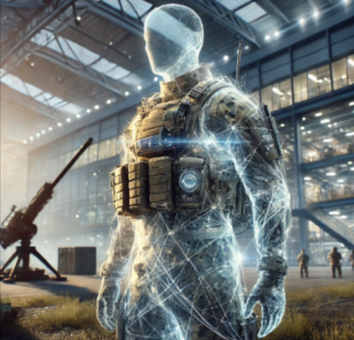In a world where technological advancements continually redefine the way we approach warfare and defense, China has introduced a cutting-edge development that could revolutionize military tactics: the first Chinese military invisible suit. This suit, which leverages the principles of cloaking technology, is a testament to China’s commitment to maintaining its competitive edge in modern warfare. The introduction of the invisible suit is not only a leap in military technology but also a clear indication of the importance of security innovation in maintaining global military balance.
A New Era of Military Technology
The concept of invisibility has long been a staple of science fiction, but recent advancements in material sciences and optics have brought this once-fantastical idea closer to reality. China’s invisible suit employs a combination of advanced metamaterials, nanotechnology, and adaptive camouflage techniques that enable it to bend light around the wearer, making it nearly invisible to the naked eye.
Metamaterials are engineered materials that have properties not typically found in nature. These materials can manipulate electromagnetic waves, including light, to create a cloaking effect. While still in its experimental stages, China’s use of metamaterials in the invisible suit shows that the country is at the forefront of innovations in security technology.
How Does It Work?
The Chinese invisible suit operates with a sophisticated array of sensors and materials designed to mimic the surrounding environment. The suit can change its appearance based on the wearer’s surroundings, often called “adaptive camouflage.” By blending seamlessly into the environment, the person wearing the suit becomes virtually undetectable to the human eye and some surveillance systems.
In terms of actual functionality, the suit may not make someone entirely “invisible” like in movies. Instead, it reduces the person wearing it, making them hard to spot, especially in dynamic combat environments where quick movements and visual distractions can provide additional cover. The technology also aims to evade detection by infrared and thermal imaging systems, further enhancing its military utility.
Strategic Military Implications
The launch of this invisible suit represents a significant shift in military strategy and tactics. In traditional warfare, visibility often plays a critical role in the effectiveness of combat operations. Soldiers who can move undetected by the enemy have a significant advantage in reconnaissance, ambush tactics, and infiltration missions. By making soldiers less visible, China can drastically increase the success rates of these operations while minimizing risks to its personnel.
This development could also serve as a deterrent to adversaries, as the possibility of facing undetectable soldiers on the battlefield might encourage enemies to reconsider aggressive actions. Invisible suits could be particularly effective in guerilla warfare, where blending into the environment is key to survival and success. Furthermore, the suit’s ability to evade visual and infrared detection means that it could be useful in urban, forest, desert, and even snowy environments, giving it a versatility that few military innovations can match.
The Security Arms Race
China’s development of an invisible suit also raises questions about the global arms race in military technology. As nations continue to push the boundaries of what’s possible, innovations like this one can shift the balance of power on the global stage. The invisible suit represents more than just a tactical advantage; it also signifies China’s growing influence in military innovation.
Countries like the United States, Russia, and others will likely respond by ramping up their research into cloaking and stealth technologies. While China may have taken the lead with this invention, the arms race is far from over. Future developments may include more advanced cloaking technologies, improved sensor systems, and countermeasures to neutralize these suits.
The invisible suit also could change international relations, particularly in regions with existing tensions. Advanced military technology tends to make a nation more influential on the global scene; China is establishing itself as a major military force, and its invisible suit is just one more sign of this.
Ethical Concerns and Military Transparency
As with any new military technology, the invisible suit raises important ethical questions. The idea of soldiers becoming invisible on the battlefield introduces a new level of psychological warfare. Some argue that invisibility might lead to more covert, and potentially more dangerous, military engagements. It could increase the risks for both military personnel and civilians, as combatants may not be able to distinguish between combatants and non-combatants.
Additionally, there are concerns about the impact of invisible technology on military transparency. International laws and conventions governing warfare emphasize the need for clear distinctions between combatants and civilians, and invisible technology could complicate efforts to uphold these principles. Furthermore, while military advancements can deter aggression, they also have the potential to escalate conflicts, especially if adversaries feel compelled to develop similar or even more destructive technologies in response.
Civilian Applications and Future Potential
While the invisible suit is primarily designed for military use, its development has sparked interest in potential civilian applications. Cloaking technology could be used in aviation, transportation, and even entertainment. For example, invisible vehicles could reduce traffic congestion by allowing cars to “see through” one another. In entertainment, virtual and augmented reality experiences could benefit from cloaking technology, making them more immersive and interactive.
In the medical field, cloaking technology could be used for non-invasive imaging techniques, allowing doctors to “see through” patients and detect illnesses or injuries without surgery. Environmental scientists could use the technology to observe wildlife without disturbing their natural habitats.
Although these applications are still far from being realized, the invisible suit demonstrates how military innovations often pave the way for civilian advancements. As the technology becomes more refined, its potential uses will likely expand beyond the battlefield.
Conclusion: A Game-Changer in Security
China’s development of the first military invisible suit marks a significant milestone in the ongoing evolution of warfare. As nations continue to innovate in the realm of security, the invisible suit serves as a reminder that the future of warfare will be defined not only by traditional weapons but also by advanced technologies that can give armies unprecedented strategic advantages.
While the suit may not make soldiers entirely invisible, its ability to reduce visibility and evade detection is a game-changer in modern combat. As the global arms race intensifies, innovations like these will shape the future of military strategy, diplomacy, and regional security.
In a world where unseen threats are becoming more common, the invisible suit may be the latest in a long line of technological advancements designed to preserve security in an increasingly complex and dangerous world.





